Entrepreneurs history in ancient age – Industrial Age
Industrial age
Standardization of materials and equipment has allowed machinery to replace labor that can cope with non-standard decisions since the beginning of the Industrial Revolution. The most significant changes occurred in the industries as a result of mechanization. Because of mechanization, agriculture started to be replaced by the industry as the backbone of the societal economy.
Entrepreneurs encouraged industrialization because they were the adventurous men that initiated businesses and industries, betting on innovative manufacturing procedures that they considered were good to modernize factory production. Many times, entrepreneurs risked their investments and savings to pursue a dream resulting in the birth of new industries and the development of numerous job opportunities.
The first industrial revolution
At the time people witnessed massive extraction of coal as well as the crucial invention of the steam engine, which led to the development of a new form of energy that later helped speed up the manufacturing of railroads, thus accelerating the economy. Entrepreneurs played a significant role in transforming the country. Matthew Boulton, an entrepreneur at that time invested and partnered with John Watt to increase the performance of steam engines, reducing waste and dramatically increasing their capacity, efficiency, and cost-effectiveness.
Entrepreneurs were funding and contributing ideas to the industrialization process, which ultimately resulted in the steam engine’s rotary motion being used for purposes other than pumping water. The steam engine is still used in many other areas today. When an invention succeeds, entrepreneurs become wealthier and want to spend more.
The second industrial revolution
Nearly a century later, the world is experiencing the second industrial revolution. With major technological advances in the field of industries, a new source of energy has emerged.
Oil refinery entrepreneur John D Rockerfeller
Entrepreneur continues to investing in new technologies like electricity, gas, and oil. Sensing an opportunity in the flourishing industrial environment, entrepreneur John D Rockerfeller proposed building an oil refinery and founding the Standard Oil Company, which later dominated the America region. Being a successful entrepreneur, Rockerfeller made oil a low-cost comfort for the poor, allowing them to illuminate for after-dark activities like reading or working, as well as provide warmth to their homes. One of the characteristics of an entrepreneur is to help others life to be better, directly and indirectly.
Risk-taker and Never-say-die attitude
As his company expanded, smaller companies suffered and eventually died. Rather than seeing his fellow entrepreneur die, he agreed to buy out the company’s rivals and pay them cash or shares in his own company. A reputable businessman like Rockerfeller desired goodwill in the future. Moving forward, Russia posed a challenge by drilling and exporting their abundant oil, disrupting the American oil industry. Being a risk-taker himself, Rockerfella invested time and resources in “Lima” oil to develop a cheaper cost against Russia. With his never-give-up attitude, Rockerfella set out to research the foreign market in order to beat the Russian. He won by his efficiency and innovative and his foresight helped him get his price close. With his visionary and leadership skill, he delegated the right jobs to the right people propelling Standard Oil Company to one of the most successful businesses in America.
Transformation of industrial age
The growth of steel demand, chemical synthesis, and communication methods such as the telegraph and telephone were also important aspects of the second industrial revolution. Finally, entrepreneur Henry Ford’s invention of the automobile, and the plane in the beginning of the 20th century are the reasons why the second industrial revolution is still regarded as the most important one!
The industrial revolution transformed agriculture and handicrafts-based economies into economies based on large-scale industry, mechanized manufacturing, and the factory system.
New machines, new power sources, and new ways of organizing work increased the productivity, efficiency, and profitability of established businesses. New industries emerged as well, like the automobile industry in the late nineteenth century.







Agriculture started to be replaced by the industry as the backbone of the societal economy.